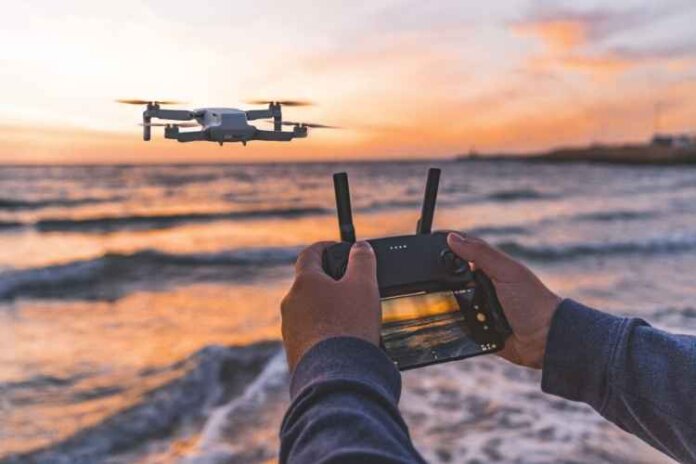
Drones are able to fly because of the four rotors that are attached to it. The rotors create a lift and push the drone forward. The rotors are also able to spin in the opposite direction, which allows the drone to move backwards or sideways.
In order to control a drone on the ground, a user needs to input commands into a controller. The controller sends a wireless signal to the drone, which tells it what to do. The controller has two sticks- one for moving the drone forwards, backwards, and sideways, and one for rotating the drone.
But what makes a long range drone possible to fly to far distances? How does it work? If you want to know more about this, then we invite you to continue reading this post.
Factors That Allow An Unmanned Aerial Vehicle To Fly On The Air
There are several factors that can affect how a drone fly. The most important factors are the weather conditions and the weight of the drone.
To be specific, the weather conditions can affect how a drone flies because the wind can blow the drone off course. The temperature can also affect the flight capability of the UAV machine. Drones work best in warm weather, and they may not fly as well in cold weather.
Battery life is an important factor to consider when flying a drone. A longer battery life means that the drone can stay in the air for a longer period of time. However, a longer battery life also means that the drone will be heavier, and it will be less maneuverable.
Aside from that, the weight of the drone is also important. A heavier drone will be harder to lift off the ground, and it will be less maneuverable than a lighter drone. A heavier drone will also have a shorter battery life.
Speed is another important factor to consider when flying a drone. A faster drone can travel further than a slower drone. However, a faster drone is also more likely to crash.
The shape of the frame can also affect the flight of the drone. An airframe with a lot of sharp angles will cut through the air more easily, and it will be able to travel faster than a rounder model of the same size.
In addition, the material of the frame is also important because some materials are stiffer than others. A more flexible frame can help to absorb some of the impact of a crash, but it won’t be as durable as a stiffer model.
The average range of a long range drone is about 1,000 meters. However, there are some drones that can fly up to 5,000 meters like the long range drones from AirborneDrones.co. And these types of UAVs are perfect for capturing aerial footage or for conducting surveillance missions.
What Makes UAV Fly Far Away From Its Controller?
The drone machine can fly and a user (ground pilot) needs to input commands into a controller. The controller sends a wireless signal to the drone, which tells it what to do. The controller has two sticks- one for moving the drone forwards, backwards, and sideways and one for rotating the drone.
The control frequency is essential to allow a drone to fly far because it determines how fast the drone responds to the user’s commands. The higher the control frequency, the faster the drone will respond. This is important because it allows the drone to navigate through obstacles and stay in contact with the controller. If the control frequency was too low, the drone would not be able to react quickly enough to avoid obstacles or maintain contact with the controller.
What Happens If The Drone Flies Away From Its Usual Range?
If a drone loses signal from its controller, it will automatically fly back to the last location where it had contact with the controller. This is known as “return to home” mode. Most drones have this feature, because it helps to prevent drones from getting lost. If a drone does lose signal from its controller, it will fly back to the last location where it had contact with the controller. This is known as “return to home” mode. Most drones have this feature, because it helps to prevent drones from getting lost.
Legal Guidelines On Using Long Range Drones
Long range drones are becoming increasingly popular, and as a result, the regulations surrounding their use are becoming more complex. In the United States, the Federal Aviation Administration (FAA) is responsible for regulating the use of drones. There are a number of regulations that drone pilots must comply with, including:
– Registering your drone with the FAA
– Flying your drone only in daylight hours
– Flying your drone below 400 feet
– Keeping your drone within visual line of sight
– Not flying your drone near airports or other aircraft
– Flying your drone under 100 mph
– Not flying your drone above crowds of people
Remember that these are only the regulations in the United States. Other countries may have additional or different requirements when it comes to operating a long range drone. It is important for you to comply with all applicable laws and regulations at all times.











